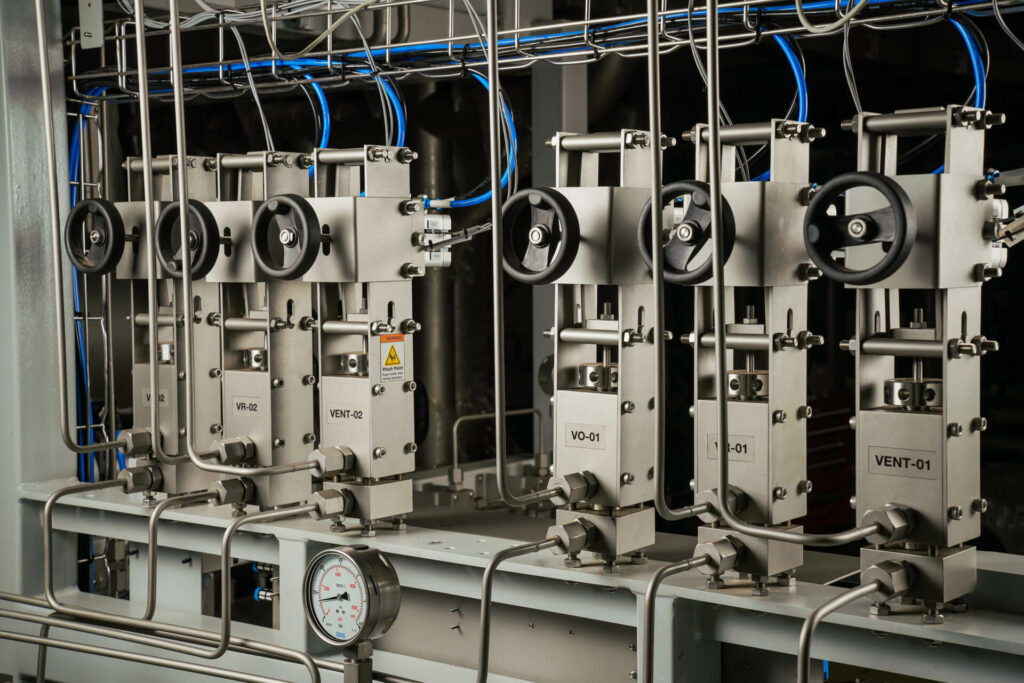In the demanding arena of industrial-scale botanical and pharmaceutical processing, supercritical CO₂ extraction stands as a pinnacle of efficiency and purity. By elevating carbon dioxide beyond its critical point of 31.1°C and 73.9 bar, this method transforms CO₂ into a supercritical fluid with liquid-like solvency and gas-like diffusivity, ideal for extracting high-value compounds such as cannabinoids, terpenes, and essential oils from organic materials. Buffalo Extraction Systems' Level 3 supercritical CO₂ extractor represents the apex for large-scale operations, featuring massive 100-, 200-, or 500-liter extraction vessels configurable in 2 or 3 units. This co2 extraction machine, operating as a closed loop CO₂ extractor, processes vast quantities of milled, pelletized, or granulated biomass at pressures of 350-650 bar (5000-9500 PSI) and temperatures of 70-110°C (158-230°F). Central to its appeal is the "faster process" benefit, enabling accelerated industrial output through high-capacity design and intelligent automation. For enterprises scouting a co2 extraction machine for sale, the Level 3's scalability justifies its supercritical CO₂ extraction machine price by slashing cycle times and boosting throughput in supercritical fluid extraction equipment. Integrated with the proprietary SCADA Systems for recipe-based control and Series Extractor mode, it redefines efficiency for sectors like nutraceuticals and food production.
The Core Mechanics of Level 3 Supercritical CO₂ Extraction
The Level 3 co2 extraction system operates in batch mode, leveraging food-grade CO₂ as a solvent to target specific components based on pressure-temperature profiles. A robust high-pressure pump, delivering 600-3000 LPH flow rates, compresses and circulates CO₂ through the extractors, where it dissolves oils from raw materials. The laden stream then advances to dual separators with individually controlled pressures, fractionating extracts—lighter volatiles in one, denser resins in the other. The CO₂ Feeding & Recovery System recycles the solvent by condensing it into liquid form for immediate reuse, embodying the "reusability of CO₂" that underpins its closed-loop efficiency, as detailed on Buffalo's site.
Unlike smaller systems, the Level 3 co2 extract machine handles industrial volumes, with automatic changeover valves enabling seamless transitions in Single or Series configurations. Certifications such as CE, ASME, GMP, and PED ensure compliance for high-stakes environments. The co-solvent pump adds versatility, injecting modifiers like ethanol to broaden extraction scopes without compromising speed. This architecture not only preserves raw material integrity—via "minimum damage to raw material" and "anti-hydrolysis" properties—but accelerates the entire workflow, making it a cornerstone for facilities aiming to ramp up production in supercritical CO₂ extraction equipment.
Key Ways Level 3 Accelerates Industrial Output
The Level 3 system's "faster process" advantage stems from engineering that prioritizes speed without sacrificing precision. Here's how it propels efficiency in a c02 extraction machine:
1. High-Capacity Vessels and Elevated Flow Rates for Rapid Throughput
At the heart of acceleration is the system's massive scale: 100-500 liter extractors, paired with 2 or 3 units, process substantial biomass loads per batch—far surpassing mid-tier models. The CO₂ pump's 600-3000 LPH flow rate ensures swift solvent circulation, saturating materials quickly and extracting compounds in condensed cycles. Buffalo's site notes "consistent flow control of the pump speed delivers highest levels of extraction efficiency," allowing operators to maintain optimal solvency without bottlenecks.
In Series mode, CO₂ cascades sequentially through vessels, enabling continuous operation—one extractor loads while others process—via automatic valves. This staggered approach minimizes idle time, transforming batch durations from hours to streamlined sequences. For industrial users of co2 extraction systems, this means handling tons of feedstock daily, ideal for high-demand extracts like CBD isolates or flavor oils, directly amplifying output in supercritical CO₂ extraction machines.
2. Automated Changeovers and Minimal Downtime for Uninterrupted Runs
Downtime erodes industrial productivity, but Level 3 counters it with innovative hardware. The "unique extractor closure design" facilitates rapid vessel swaps, while "proprietary changeover valves" handle isolations at full pressure, ensuring quick transitions even under 650 bar. As per Buffalo's features, this setup supports "rapid batch changeovers with minimal interruption," keeping the line moving.
Superior sealing technology further reduces maintenance halts, preserving momentum in closed loop CO₂ extractors. The SCADA Systems remote monitoring dashboards track valve states and flow metrics in real-time, with alerts for anomalies, empowering proactive adjustments. In a co2 extraction machine price landscape where uptime equates to revenue, these elements enable non-stop shifts, accelerating output for facilities scaling to meet market surges in botanicals or pharmaceuticals.
3. Intelligent Control and Scalable Configurations for Optimized Cycles
Precision drives speed in the Level 3 supercritical CO₂ extractor. "Precise pressure control guarantees consistent solvent solubility," allowing tunable profiles—e.g., lower pressures for volatiles, higher for resins—that extract targeted fractions swiftly. The special separator design eases collection of resinous or low-viscosity products, streamlining downstream handling and reducing cycle tails.
The co-solvent pump integrates seamlessly, enhancing solvency for diverse compounds without extending run times. With the SCADA System recipe automation, operators preload multi-stage protocols, syncing with PLCs for hands-off execution. This "intuitive intelligence" cuts operator intervention, fostering scalability: configure for 2 vessels in pilot runs or 3 in full production. The "non-flammable" and "non-toxic" CO₂ ensures safe, GMP-compliant operations at pace, while reusability minimizes refills, sustaining high-velocity cycles in co2 extraction equipment.
4. Sustainability Synergies That Fuel Long-Term Acceleration
Efficiency extends beyond speed to resource optimization. The closed-loop recycling, coupled with "100% food grade" CO₂, avoids waste, enabling repeated batches without pauses for solvent sourcing. "Better stability in formulation" preserves extract quality across accelerated runs, reducing reworks. For a supercritical CO₂ extraction machine price investment, this holistic approach—faster processes with "cost efficient" operations—delivers compounded gains, positioning Level 3 as an industrial accelerator.
Industry Transformation Through Accelerated Extraction
Level 3 systems herald a new era for supercritical fluid extraction equipment, where "faster process" translates to agile manufacturing. By harnessing large vessels, potent pumps, and smart automation, they empower enterprises to outpace competitors, meeting escalating demands for clean-label products. As global markets evolve, Buffalo's design—certified for rigor—ensures reliability at scale.
For decision-makers eyeing co2 extraction machine for sale, the Level 3 isn't merely equipment; it's a throughput engine, blending velocity with precision to redefine industrial output. In a co2 extraction system, this acceleration isn't optional—it's essential for leadership.




